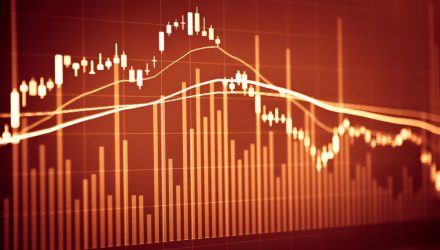After a strong performance to start the session Monday, stocks and index ETFs tumbled into the close, leaving on the Dow Jones Industrial Average positive on the day. Inverse ETFs shined.
Early in the session, stocks and index ETFs were mixed to higher, continuing their recovery on Monday, as investors were invigorated by Senate approval of a fresh coronavirus stimulus package, helping to boost companies set to benefit from an economic return.
The S&P 500 had climbed almost 1%, buoyed by financial stocks, while the Dow Jones Industrial Average added 460 points or 1.5% in morning and market afternoon trading. But by the close, the S&P 500 was down 0.54%, while the Nasdaq Composite lost 2.41% as tech volatility and a rotation out of big tech names like Google and Apple dragged the index lower.
Major stock ETFs ended mixed to lower on Monday as well. The SPDR Dow Jones Industrial Average ETF (DIA) climbed modestly, while the SPDR S&P 500 ETF Trust (SPY) and Invesco QQQ Trust (QQQ) both continued a sharp decline into the close in afternoon trading.
“More stimulus could provide a big lift to the stock market, but it may come with some bumps,” said Lindsey Bell, chief investment strategist at Ally Invest. “Runaway inflation worries have been a stumbling block for stocks as of late. Because of this, there could be more market weakness ahead as investors grapple with the short- and long-term effects of stimulus. High-flying stocks like tech and the ‘stay at home’ stocks may be hit the hardest.”
Tech stocks continued to take the pressure due to climbing interest rates, an ongoing trend for the last few weeks. Such stocks are particularly vulnerable as higher rates reduce the value of future cash flows.
Markets have been jittery lately, as the benchmark 10-year yield has spiked in recent weeks. The 10-year Treasury yield climbed another 4 basis points to 1.6% Monday, after commencing 2021 below 1%.
Will Rates Go Much Higher?
But some, like David Tepper, feel that the nosedive in Treasuries that has driven rates higher, as rates run opposite to bonds, is likely finished, as big foreign buyers like Japan are set to come at for lower prices.
“Basically I think rates have temporarily made the most of the move and should be more stable in the next few months, which makes it safer to be in stocks for now,” Tepper told CNBC’s Joe Kernen, who shared the comments on “Squawk Box.”
The market rotation has created a considerable divergence among the major stock averages and index ETFs. For March, the Dow Industrials, which contains a heftier number of stocks that could benefit from an economic reopening, is up 2.8%, while the Nasdaq Composite has fallen 4.4%. Meanwhile, the broader S&P 500 is treading water with a 0.3% gain.
Inverse ETF investors were pleased with Monday afternoon’s market performance however, as ETFs like the ProShares UltraPro Short Dow 30 (SDOW) and the Direxion Daily S&P 500 Bear 1X (SPDN) tend to outperform in this type of environment. Inverse ETFs are typically best for more savvy investors who are willing to take on additional risk.
For more market trends, visit ETF Trends.
